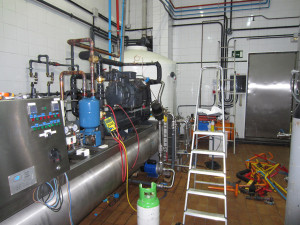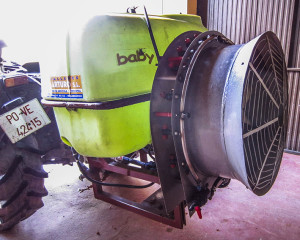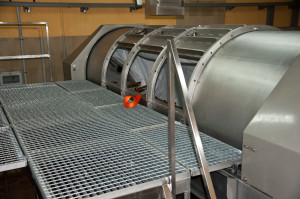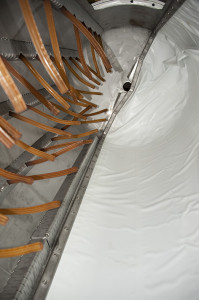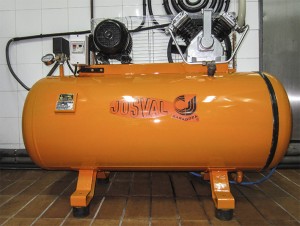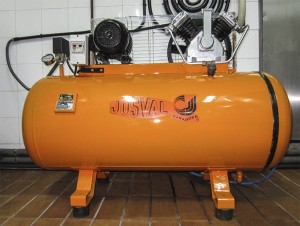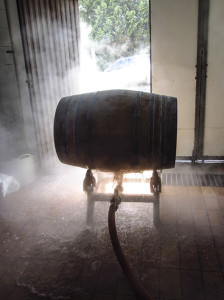 One of the questions that we are most frequently asked about our wine making is whether we use any oak or not. My answer is always a most emphatic “NO”. When it comes to wine, and not just albariño, at Castro Martin we always want to be known as purists – our ultimate goal is quite simply to make a wine that is an honest expression of our grape variety, untainted by flavours of yeast, oak or any other additive for that matter.
One of the questions that we are most frequently asked about our wine making is whether we use any oak or not. My answer is always a most emphatic “NO”. When it comes to wine, and not just albariño, at Castro Martin we always want to be known as purists – our ultimate goal is quite simply to make a wine that is an honest expression of our grape variety, untainted by flavours of yeast, oak or any other additive for that matter.
Having said all that, I can sometimes understand why people might ask….. a young albariño is always fresh, clean, zesty with a lovely concentration of intense, focused fruit, but then, with a little extended ageing, all that can change. After a year or two in bottle, quite naturally, the wine will start to evolve (this is not to be confused with oxidation, which is something completely different). Older albariño can start to develop secondary aromas and flavours that are perhaps more usually associated with oak aged or barrel fermented wines – it can develop a slightly ‘honeyed’ sweetness, with just a touch of toffee or caramel. Altogether quite different from its original, widely known style. In some ways it’s a bit of a shame that consumers really only know our wine in its young, zesty form, and normally don’t get to experience its older alter ego (unless they find a forgotten bottle at the bottom of their wine cupboard). When stored correctly an older, well-made albariño can actually become quite an interesting wine.
So why does today’s photo show a barrel being steam cleaned in our bodega, you may ask? OK, so I’ll admit it, we do make a very small amount of barrel aged (not fermented) albariño for a very specific customer. Not necessarily my own personal taste, but if there’s a niche market for this wine, then why not? I should add that we can only oak age wine in certain vintages, when the wine has sufficient body and weight to support the oak. If the vintage is not suitable you may just end up with a glass of oak and acidity – altogether unpleasant.
 One of the questions that we are most frequently asked about our wine making is whether we use any oak or not. My answer is always a most emphatic “NO”. When it comes to wine, and not just albariño, at Castro Martin we always want to be known as purists – our ultimate goal is quite simply to make a wine that is an honest expression of our grape variety, untainted by flavours of yeast, oak or any other additive for that matter.
One of the questions that we are most frequently asked about our wine making is whether we use any oak or not. My answer is always a most emphatic “NO”. When it comes to wine, and not just albariño, at Castro Martin we always want to be known as purists – our ultimate goal is quite simply to make a wine that is an honest expression of our grape variety, untainted by flavours of yeast, oak or any other additive for that matter.
Having said all that, I can sometimes understand why people might ask….. a young albariño is always fresh, clean, zesty with a lovely concentration of intense, focused fruit, but then, with a little extended ageing, all that can change. After a year or two in bottle, quite naturally, the wine will start to evolve (this is not to be confused with oxidation, which is something completely different). Older albariño can start to develop secondary aromas and flavours that are perhaps more usually associated with oak aged or barrel fermented wines – it can develop a slightly ‘honeyed’ sweetness, with just a touch of toffee or caramel. Altogether quite different from its original, widely known style. In some ways it’s a bit of a shame that consumers really only know our wine in its young, zesty form, and normally don’t get to experience its older alter ego (unless they find a forgotten bottle at the bottom of their wine cupboard). When stored correctly an older, well-made albariño can actually become quite an interesting wine.
So why does today’s photo show a barrel being steam cleaned in our bodega, you may ask? OK, so I’ll admit it, we do make a very small amount of barrel aged (not fermented) albariño for a very specific customer. Not necessarily my own personal taste, but if there’s a niche market for this wine, then why not? I should add that we can only oak age wine in certain vintages, when the wine has sufficient body and weight to support the oak. If the vintage is not suitable you may just end up with a glass of oak and acidity – altogether unpleasant.




